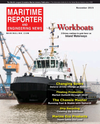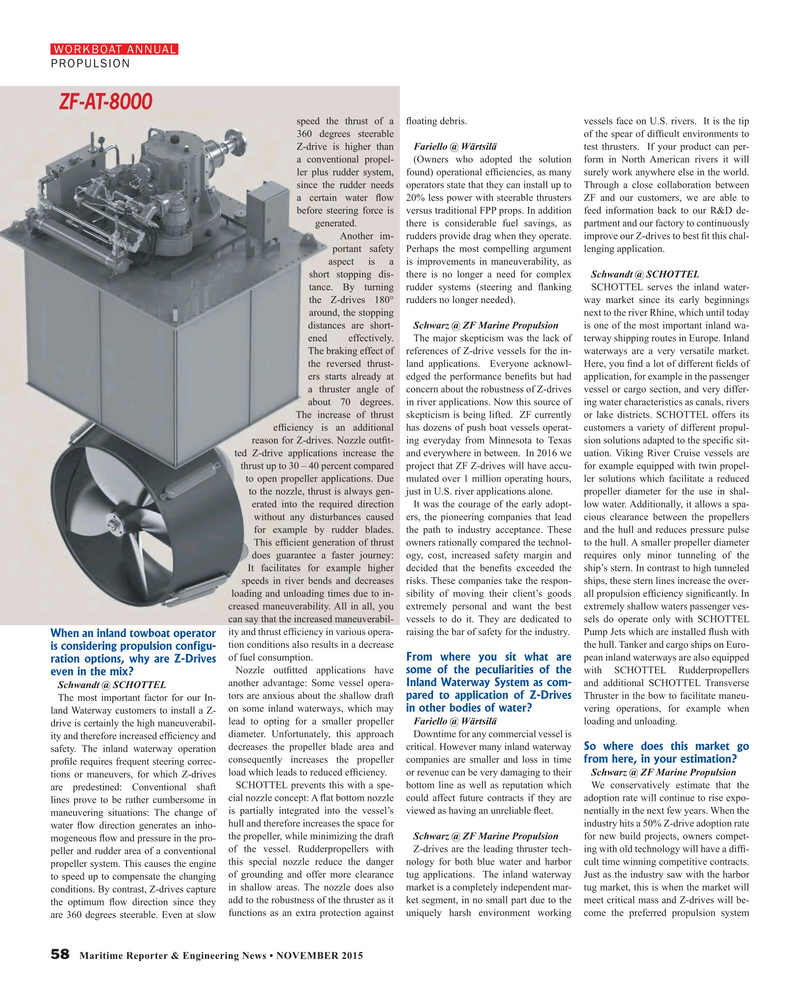
Page 58: of Maritime Reporter Magazine (November 2015)
Workboat Edition
Read this page in Pdf, Flash or Html5 edition of November 2015 Maritime Reporter Magazine
WORKBOAT ANNUAL
PROPULSION
ZF-AT-8000 speed the thrust of a ? oating debris. vessels face on U.S. rivers. It is the tip 360 degrees steerable of the spear of dif? cult environments to
Z-drive is higher than Fariello @ Wärtsilä test thrusters. If your product can per- a conventional propel- (Owners who adopted the solution form in North American rivers it will ler plus rudder system, found) operational ef? ciencies, as many surely work anywhere else in the world. since the rudder needs operators state that they can install up to Through a close collaboration between a certain water ? ow 20% less power with steerable thrusters ZF and our customers, we are able to before steering force is versus traditional FPP props. In addition feed information back to our R&D de- generated. there is considerable fuel savings, as partment and our factory to continuously
Another im- rudders provide drag when they operate. improve our Z-drives to best ? t this chal- portant safety Perhaps the most compelling argument lenging application. aspect is a is improvements in maneuverability, as short stopping dis- there is no longer a need for complex Schwandt @ SCHOTTEL tance. By turning rudder systems (steering and ? anking SCHOTTEL serves the inland water- the Z-drives 180° rudders no longer needed). way market since its early beginnings around, the stopping next to the river Rhine, which until today distances are short- Schwarz @ ZF Marine Propulsion is one of the most important inland wa- ened effectively. The major skepticism was the lack of terway shipping routes in Europe. Inland
The braking effect of references of Z-drive vessels for the in- waterways are a very versatile market. the reversed thrust- land applications. Everyone acknowl- Here, you ? nd a lot of different ? elds of ers starts already at edged the performance bene? ts but had application, for example in the passenger a thruster angle of concern about the robustness of Z-drives vessel or cargo section, and very differ- about 70 degrees. in river applications. Now this source of ing water characteristics as canals, rivers
The increase of thrust skepticism is being lifted. ZF currently or lake districts. SCHOTTEL offers its ef? ciency is an additional has dozens of push boat vessels operat- customers a variety of different propul- reason for Z-drives. Nozzle out? t- ing everyday from Minnesota to Texas sion solutions adapted to the speci? c sit- ted Z-drive applications increase the and everywhere in between. In 2016 we uation. Viking River Cruise vessels are thrust up to 30 – 40 percent compared project that ZF Z-drives will have accu- for example equipped with twin propel- to open propeller applications. Due mulated over 1 million operating hours, ler solutions which facilitate a reduced to the nozzle, thrust is always gen- just in U.S. river applications alone. propeller diameter for the use in shal- erated into the required direction It was the courage of the early adopt- low water. Additionally, it allows a spa- without any disturbances caused ers, the pioneering companies that lead cious clearance between the propellers for example by rudder blades. the path to industry acceptance. These and the hull and reduces pressure pulse
This ef? cient generation of thrust owners rationally compared the technol- to the hull. A smaller propeller diameter does guarantee a faster journey: ogy, cost, increased safety margin and requires only minor tunneling of the
It facilitates for example higher decided that the bene? ts exceeded the ship’s stern. In contrast to high tunneled speeds in river bends and decreases risks. These companies take the respon- ships, these stern lines increase the over- loading and unloading times due to in- sibility of moving their client’s goods all propulsion ef? ciency signi? cantly. In creased maneuverability. All in all, you extremely personal and want the best extremely shallow waters passenger ves- can say that the increased maneuverabil- vessels to do it. They are dedicated to sels do operate only with SCHOTTEL ity and thrust ef? ciency in various opera- raising the bar of safety for the industry. Pump Jets which are installed ? ush with
When an inland towboat operator tion conditions also results in a decrease the hull. Tanker and cargo ships on Euro- is considering propulsion configu- of fuel consumption. pean inland waterways are also equipped
From where you sit what are ration options, why are Z-Drives some of the peculiarities of the
Nozzle out? tted applications have with SCHOTTEL Rudderpropellers even in the mix?
Inland Waterway System as com- another advantage: Some vessel opera- and additional SCHOTTEL Transverse
Schwandt @ SCHOTTEL pared to application of Z-Drives tors are anxious about the shallow draft Thruster in the bow to facilitate maneu-
The most important factor for our In- in other bodies of water?
on some inland waterways, which may vering operations, for example when land Waterway customers to install a Z- lead to opting for a smaller propeller Fariello @ Wärtsilä loading and unloading.
drive is certainly the high maneuverabil- diameter. Unfortunately, this approach Downtime for any commercial vessel is ity and therefore increased ef? ciency and
So where does this market go safety. The inland waterway operation decreases the propeller blade area and critical. However many inland waterway from here, in your estimation?
consequently increases the propeller companies are smaller and loss in time pro? le requires frequent steering correc- tions or maneuvers, for which Z-drives load which leads to reduced ef? ciency. or revenue can be very damaging to their Schwarz @ ZF Marine Propulsion are predestined: Conventional shaft SCHOTTEL prevents this with a spe- bottom line as well as reputation which We conservatively estimate that the lines prove to be rather cumbersome in cial nozzle concept: A ? at bottom nozzle could affect future contracts if they are adoption rate will continue to rise expo- maneuvering situations: The change of is partially integrated into the vessel’s viewed as having an unreliable ? eet. nentially in the next few years. When the hull and therefore increases the space for industry hits a 50% Z-drive adoption rate water ? ow direction generates an inho- the propeller, while minimizing the draft Schwarz @ ZF Marine Propulsion for new build projects, owners compet- mogeneous ? ow and pressure in the pro- peller and rudder area of a conventional of the vessel. Rudderpropellers with Z-drives are the leading thruster tech- ing with old technology will have a dif? - propeller system. This causes the engine this special nozzle reduce the danger nology for both blue water and harbor cult time winning competitive contracts. to speed up to compensate the changing of grounding and offer more clearance tug applications. The inland waterway Just as the industry saw with the harbor conditions. By contrast, Z-drives capture in shallow areas. The nozzle does also market is a completely independent mar- tug market, this is when the market will the optimum ? ow direction since they add to the robustness of the thruster as it ket segment, in no small part due to the meet critical mass and Z-drives will be- are 360 degrees steerable. Even at slow functions as an extra protection against uniquely harsh environment working come the preferred propulsion system 58 Maritime Reporter & Engineering News • NOVEMBER 2015
MR #11 (58-65).indd 58 11/2/2015 11:14:23 AM

 57
57

 59
59
